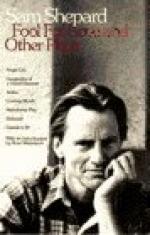|
This section contains 306 words (approx. 1 page at 400 words per page) |

|
Fool for Love Summary & Study Guide Description
Fool for Love Summary & Study Guide includes comprehensive information and analysis to help you understand the book. This study guide contains the following sections:
This detailed literature summary also contains Bibliography on Fool for Love by Sam Shepard.
Sam Shepard's Fool for Love is arguably the playwright's best known play. Focusing, as many of Shepard' s plays do, on the dark side of life in the West, Fool for Love was first produced at the Magic Theatre in San Francisco in February, 1983, before moving to Off-Broadway at the Circle Repertory Theatre in May of that year. Shepard himself directed these original productions, winning Obie Awards for his writing and directing as well as the award for best new American play.
Critics gave Fool for Love mixed reviews. The play is primarily a struggle, mostly of words, between two on-again/off-again lovers, Eddie and May. By the end of the play, it is revealed that this is an incestuous relationship between half-siblings. Some of the dissenting critics found the dialogue between them, especially at the beginning of the play, to be cliched. Others believed that Shepard was covering territory and themes that he had dealt with to better effect in plays such as Buried Child and True West, adding nothing new and going nowhere fast. Critics who praised the play found the character of May to be one of the first strong, autonomous women created by Shepard. Some critics also found the device of the Old Man, a ghostlike presence on stage, to be very effective.
Most critics agreed that with this new play, Shepard continued his exploration of the mythic American Westparticularly as it was portrayed in the pulp entertainment of the 1950s and 1960sand its extrapolation to contemporary environments and relationships. As Frank Rich wrote in the New York Times, ' 'Fool for Love is a western for our time. We watch a pair of figurative gunslingers fight to the finishnot with bullets, but with piercing words that give ballast to the weight of a nation's buried dreams."
Read more from the Study Guide
|
This section contains 306 words (approx. 1 page at 400 words per page) |

|



